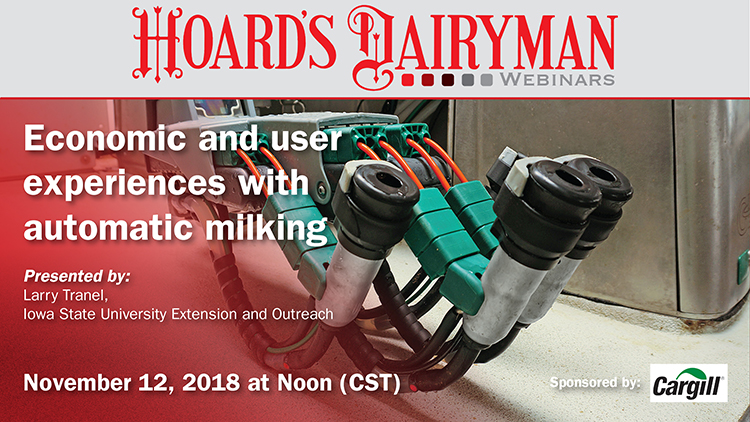
“What’s it worth to me?” That is a common question asked when making any high-value purchase. Will this save me money? Will it decrease manual labor? Is it a good fit for our operation?
All of those questions are certainly valid ones when deciding if putting in robots to milk your cows is a good idea. While it is a simple “yes, install them” or a “no, that is not for us” answer, the thought behind the decision is far from simple.
Larry Tranel, Iowa State University Extension and Outreach, has been on 1,500 dairy farms in his career and specializes in automatic milking systems (AMS) — and the economics of them. He shared data with webinar attendees when he presented “Economic and user experiences with automatic milking.”
“It’s a tool — not a solution,” announced Tranel at the beginning of the presentation.
His presentation contained feedback and surveys from producers using robots. While dairy farming is a business, it generally is a family business and the value of the family in that equation is important. What is that extra family time worth? That was a variable in the financial equations — how do I put a price tag on that? But, that value influences the feasibility of robots.
The method Tranel uses to calculate robot economics is with his DIRTI5 formula. Those letters stand for depreciation, interest, repair, taxes, and insurance.
The initial cost of the set-up and interest paid on that investment can be substantial. Typical costs for annual repairs runs about $8,000. There is also a greater insurance expense as you now have a larger investment to protect.
The dollars and cents of robotic milking might be best summarized with the idea that a robot or robots equates to 15 years of paid labor on your farm. Robots can be profitable, but also consider how far out payments are spread, as that impacts cash flow.
“We often inhibit dairy cows” stated Tranel. Robotic milking systems allow cows to be free of our routines and let the cows to create their own. He was primarily speaking of the milking frequency, as cows previously milked twice a day will now more likely seek the milking stall nearly three times each day. The increase in milk production is typically 3 to 5 percent. When an AMS is installed in conjunction with a new barn (with improved cow comfort), there is typically a 6 to 8 percent increase in milk output.
According to survey respondents, somatic cell counts have decreased about 3 to 5 percent, so milk quality is a benefit of robotic milking. A downside includes purchasing pelleted feed to distribute to the cows while milking.
What happens at the end of the robot’s approximate 15 years of useful life? What about resale value? There is limited data in this area as many robots are still under that 15-year umbrella. The age of the producer is also a consideration. Is the next generation joining the operation? How long does the producer intend on being in the dairy business and how do robots fit in that equation?
The webinar contains several cost-benefit charts that I encourage you to review. Tranel’s presentation is very matter-of-fact, and includes actual robot owners’ opinions and feedback. The webinar is a great resource if you are thinking about robots and want to know the nuts and bolts of financing such an investment. The link to the archived webinar is at on.hoards.com/WB_111218. The presentation was sponsored by Cargill Animal Nutrition. This webinar and all previous ones can be found at hoards.com/webinars.
Join us next month

Bill Weiss, The Ohio State University, presents “Cutting feed costs without cutting milk” on Monday, December 10, at noon (Central time).
It is easy to cut feed costs, but it’s harder to cut costs without sacrificing milk production. This webinar will discuss controlling expenses by selecting cost-effective ingredients, grouping cows correctly, and formulating diets to provide adequate nutrients without over-formulating the ration. The webinar is sponsored by QLF.

The author is the online media manager and is responsible for the website, webinars, and social media. A graduate of Modesto Junior College and Fresno State, she was raised on a California dairy and frequently blogs on youth programs and consumer issues.








